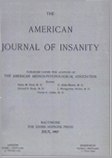EFFECT OF THYROID MEDICATION ON BRAIN METABOLISM OF CRETINS
Abstract
Brain metabolism of cretins was studied before and after the administration of desiccated thyroid. Blood was collected from an artery and the internal jugular vein and analyzed for oxygen. Cerebral blood flow was estimated with the aid of a thermostromuhr inserted in the internal jugular vein. The oxygen uptake was also determined and sustained an average rise of 22 per cent after therapy, taking the premedication value as a base line. The deviations from standard values of basal metabolic rate are also presented. The average of 29 arterio-venous oxygen differences of 11 cretins was 5.74 volumes per cent before thyroid administration and that value was reduced to 4.69 volumes per cent on 25 observations on 9 patients after therapy. In 8 cretins the average acceleration of cerebral blood flow was 57 per cent. Alterations of brain metabolism were determined by taking into consideration the changes of the arterio-venous oxygen difference and blood flow. An average increase of 32 per cent in cerebral metabolism was thus revealed as a result of the administration of thyroid. This increase in cerebral metabolism affords a basis for alterations in the cerebral electrical potentials and psychological reactions of these patients. The electroencephalograms disclosed a rise of the energy level in certain frequency ranges. Psychologically, improvement was either absent or of questionable significance in any of the higher processes. The greatest change was that of an acceleration of psychological activity, an acceleration made possible by the increased energy expenditures stimulated by thyroid medication.
Access content
To read the fulltext, please use one of the options below to sign in or purchase access.- Personal login
- Institutional Login
- Sign in via OpenAthens
- Register for access
-
Please login/register if you wish to pair your device and check access availability.
Not a subscriber?
PsychiatryOnline subscription options offer access to the DSM-5 library, books, journals, CME, and patient resources. This all-in-one virtual library provides psychiatrists and mental health professionals with key resources for diagnosis, treatment, research, and professional development.
Need more help? PsychiatryOnline Customer Service may be reached by emailing [email protected] or by calling 800-368-5777 (in the U.S.) or 703-907-7322 (outside the U.S.).



